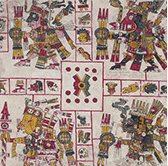Manuscript Section
The Manuscript Section today is made up of more than one hundred collections (or shelf mark series). These are very diverse, not least as regards their size, ranging from the Vaticani latini (the largest collection, with 15,371 numbered items) to several collections made up of a single item (there are now seven of these: the Borgiani egiziani, the Borgiani islandesi, the Vaticani indocinesi, the Papiri Borgiani aramaici, the Papiri Borgiani demotici, the Papiri Vaticani demotici, and the Vaticani mandei). A distinction is made between the “open” collections and the “closed” (or “historical”) ones. An “open” collection is one which is (or might in principle be) subject to growth over time, through accessions of material of the same kind (by convention, the “open” collections of manuscripts in the Vatican Library generally receive names which include the word “Vaticani”). A “closed” collection, on the other hand, is one which, due to its provenance from a previously existing library or to the peculiar historical circumstances of its formation, may no longer receive additional items, since these would be incongruent with its nature. This category of “closed” or “historical” collections includes the Palatini (made up of manuscripts which came from the German city of Heidelberg and were donated to Gregory XV in 1623 by the Maximilian I, Elector of Bavaria, in the context of the events of the Thirty Years’ War); the Urbinati (made up of manuscripts from the library which belonged to Federico da Montefeltro [1422-1482] and then to the Dukes of Urbino, and which was purchased in 1657 by Alexander VII); the Reginensi (with the collection of Queen Christina of Sweden [1626-1689] and arrived in 1690); the Capponiani (with the collection of Alessandro Gregorio Capponi [1683-1746], willed to the Vatican Library in 1746); the Ottoboniani (with the library of the Ottoboni family, purchased in 1748); the Borghesiani (with the collection of the Roman Borghese family, but including also many manuscripts from the Pontifical library at Avignon, purchased in 1891); the Barberiniani and Borgiani (both established in 1902, the first with the manuscripts of the library of the Roman Barberini family; the second with those of the library of the Sacred Congregation de Propaganda Fide, which included the rich collection of Card. Stefano Borgia [1731-1804]); the Rossiani (created from the library of Giovanni Francesco De Rossi [1796-1854], deposited in 1921 by the Society of Jesus); the Chigiani (with the library of the Chigi family, donated to Pius XI in 1923); the Ferrajoli manuscripts (with the library of the Roman family of the same name, which arrived in 1926); the Archive of the Chapter of St. Peter’s (deposited in 1940); the Patetta manuscripts (with the library of the bibliophile Federico Patetta [1867-1945, who willed it to the Vatican Library in 1945). The diversity of the manuscript collections and of their origins thus make the Vatican Library a “bibliotheca bibliothecarum”, a “library of libraries”: one, that is, which was gathered not only by the continuous efforts of the Popes, with an uninterrupted continuity going back more than half a millenium; but also by the accession of entire libraries which are mirrors of different ages, worlds and cultures, ranging from the medieval manuscripts from German, French and Central European monasteries in the Palatini and Reginensi collections to the missionary collections in the Borgiani.
CONTACT DETAILS
- DIRECTOR Dr. Claudia Montuschi: contact by email
- OFFICE: contact by email





